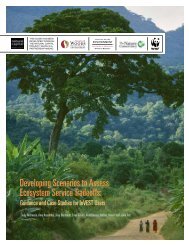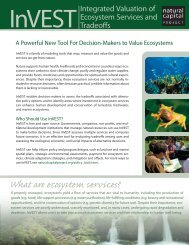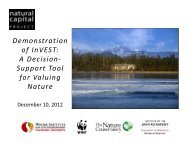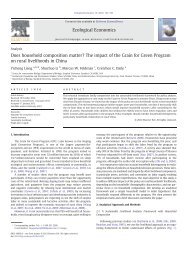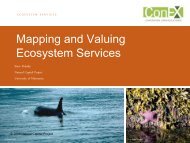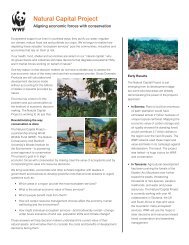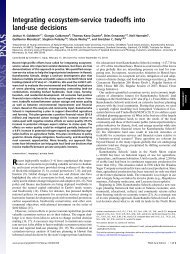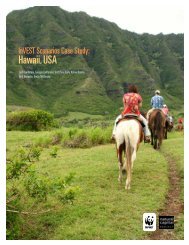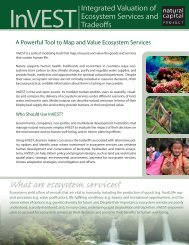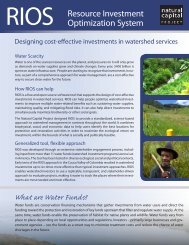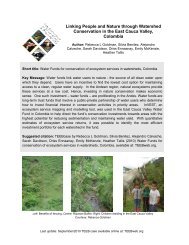Linking Ecosystem Health and Services to Inform Marine Ecosystem ...
Linking Ecosystem Health and Services to Inform Marine Ecosystem ...
Linking Ecosystem Health and Services to Inform Marine Ecosystem ...
Create successful ePaper yourself
Turn your PDF publications into a flip-book with our unique Google optimized e-Paper software.
10 arkema <strong>and</strong> samhouri<br />
ment in the United States, Canada, <strong>and</strong> elsewhere<br />
(Christensen et al. 1996; Arkema et al. 2006;<br />
Smith et al. 2007; Levin et al. 2009; McLeod<br />
<strong>and</strong> Leslie 2009). <strong>Ecosystem</strong>-based management<br />
(EBM) is an integrated approach that focuses on<br />
the influence of multiple human activities on ecosystems.<br />
The ultimate aim of EBM is <strong>to</strong> maintain<br />
ecosystem health in order <strong>to</strong> sustain the services<br />
people desire from it (McLeod et al. 2005). These<br />
two components, maintaining ecosystem health<br />
<strong>and</strong> sustaining the delivery of ecosystem services,<br />
are not independent of one other. Indeed, the<br />
provisioning of ecosystem services depends on a<br />
well-functioning ecosystem, which in turn can<br />
be modified by the dem<strong>and</strong> for various services<br />
(MEA 2005). In spite of this interconnectedness,<br />
the relationships between various attributes of<br />
ecosystem health <strong>and</strong> the delivery of specific services<br />
of interest are not well defined.<br />
“<strong>Ecosystem</strong> health” is an oft-used term in<br />
regula<strong>to</strong>ry <strong>and</strong> policy documents <strong>and</strong> in the public<br />
media (POC 2003; USCOP 2004; McLeod et al.<br />
2005; MEA 2005). Here, we operationalize <strong>and</strong><br />
define ecosystem health as attributes of ecosystem<br />
structure (e.g., species composition, physical<br />
habitat characteristics) <strong>and</strong> function (e.g., biological<br />
<strong>and</strong> physical processes) relevant <strong>to</strong> the management<br />
goal of maintaining a productive <strong>and</strong><br />
resilient ecosystem. Our underst<strong>and</strong>ing is based<br />
on various avenues of ecological research <strong>and</strong> theory,<br />
including the relationship between diversity<br />
<strong>and</strong> ecosystem function (reviewed by Srivastava<br />
<strong>and</strong> Vellend 2005), food web theory (e.g., Pimm<br />
2002; Vermaat et al. 2009), the ecosystem-based<br />
fisheries management literature (e.g., Link et al.<br />
2002; Ful<strong>to</strong>n et al. 2005), <strong>and</strong> ecosystem ecology<br />
(e.g., Odum 1969, 1985; Likens 1985; Carpenter<br />
et al. 1995). From this literature has emerged an<br />
enormous list of attributes that scientists use <strong>to</strong><br />
characterize an ecosystem, including the relative<br />
abundance <strong>and</strong> diversity of species with ecological<br />
<strong>and</strong>/or conservation importance, rates of primary<br />
<strong>and</strong> secondary production, community energetics,<br />
nutrient <strong>and</strong> trophic cycling, <strong>and</strong> resilience (Samhouri<br />
et al. 2009). These attributes describe the<br />
status of the ecosystem irrespective of the human<br />
dimension.<br />
In contrast with ecosystem health, the goal<br />
of maintaining ecosystem services focuses on<br />
endpoints that relate directly <strong>to</strong> human needs <strong>and</strong><br />
desires (NRC 2005; MEA 2005). Scientific underst<strong>and</strong>ing<br />
of the relationship between management<br />
decisions, ecosystem processes, <strong>and</strong> the delivery<br />
of benefits for humans is improving. These<br />
benefits include not only provisioning services<br />
of fish <strong>and</strong> shellfish, but also regulating services,<br />
such as control of damage from s<strong>to</strong>rms or floods,<br />
supporting services of nursery habitats <strong>and</strong> forage<br />
fish, <strong>and</strong> cultural, aesthetic, <strong>and</strong> recreational<br />
values (Daily 1997; MEA 2005). The Millennium<br />
<strong>Ecosystem</strong> Assessment (MEA) of the status of<br />
ecosystem services around the globe (MEA 2005)<br />
spawned a flurry of academic research <strong>and</strong> action<br />
by nongovernmental organizations <strong>and</strong> some<br />
international governments <strong>to</strong> increase underst<strong>and</strong>ing<br />
<strong>and</strong> awareness of the linkages between<br />
our activities <strong>and</strong> what benefits we can expect <strong>to</strong><br />
reap from ecosystems (e.g., Hayhoe et al. 2004;<br />
examples in Turner <strong>and</strong> Daily 2008). Although<br />
the MEA raised awareness of ecosystem services<br />
on a global scale, much scientific work remains <strong>to</strong><br />
be done. Decision support <strong>to</strong>ols, predictive models,<br />
<strong>and</strong> more detailed underst<strong>and</strong>ing of specific<br />
services <strong>and</strong> the relationships among them are<br />
needed <strong>to</strong> inform management decisions on local,<br />
regional, <strong>and</strong> national scales. Moreover, until<br />
recently, the focus of ecosystem services research<br />
has largely been on terrestrial ecosystem services,<br />
although advances are being made in the marine<br />
arena (Ruckelshaus <strong>and</strong> Guerry 2009; reviewed<br />
in Kareiva et al. 2011). Quantitative approaches<br />
developed for ecosystem-based fisheries management<br />
(EBFM) may be able <strong>to</strong> provide an initial<br />
step <strong>to</strong>ward quantifying the delivery of at least a<br />
subset of services provided by coastal <strong>and</strong> ocean<br />
ecosystems under alternative management scenarios.<br />
In this paper, we explore the relationship between<br />
ecosystem health <strong>and</strong> ecosystem services<br />
<strong>and</strong> seek <strong>to</strong> bridge the gap between ecosystem<br />
models developed for EBFM <strong>and</strong> modeling currently<br />
in development <strong>to</strong> map <strong>and</strong> value ecosystem<br />
services. First, we outline relationships<br />
between ecosystem attributes <strong>and</strong> ecosystem services,<br />
highlight which services existing ecosystem<br />
models are well equipped <strong>to</strong> inform, <strong>and</strong> reveal<br />
where more work is needed. Second, we use an<br />
ecosystem model <strong>to</strong> elucidate trade-offs that arise<br />
among ecosystem health attributes, among services,<br />
<strong>and</strong> among attributes <strong>and</strong> services under rep-



